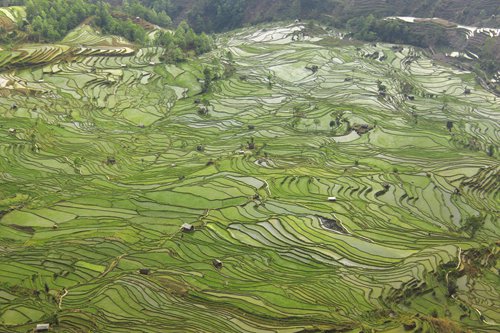The people of Yuanyang as backbone of Yunnan’s environment
By Rainer Feldbacher Source:Global Times Published: 2019/7/25 15:53:40

Rice terraces in Yuanyang, Yunnan Province Photo: Courtesy of Rainer Feldbacher
Yunnan, China's sixth largest province, is arguably one of the country's most diverse regions: The climate varies from the humid heat of the tropical rainforest in the south to the eternal snow of the Himalayan foothills in the north at altitudes from 70 to 7,000 meters above sea level. Between the peaks and glaciers are three deeply cut canyons. From there, powerful rivers roll southwards, being responsible for the early rise of culture in Asia and providing the needed water for agriculture.
These rivers, born in the mountains of Yunnan, primarily provide water and thus life.
You have the Salween, which crosses later on into Myanmar and ends in the Indian Ocean; the Mekong, which flows into the Chinese Sea after a long journey in the south of Vietnam; and last the Yangtze River, which accompanies the other two southward for a while, and then turns abruptly eastward behind the spectacular Tiger Leaping Gorge to make its way through China to the shores of Shanghai.
In addition to these cultural and life-giving rivers, tourists will find something else worth traveling for - the high mountains, which cover 80 percent of Yunnan.
Along the slopes, farmers are tearing out farmland in the form of thousands of terraces for growing rice. Yuanyang is probably home to some of the most impressive of these farmlands in the world. As varied as the country, so different is the climate. Accordingly, the botanical and zoological biodiversity is breathtaking, not least because of the thin air at the high altitudes of the north.
'Wild Yunnan'
For a long time, the western provinces were neglected in favor of the economic development along China's eastern coastal region.
In the recent years, China has been investing a lot and strengthening the infrastructure in all provinces.
Yunnan has been declared a tourist development area and historic sites have been restored, such as the well-visited cities of Dali and Lijiang. On the one hand, some cities resemble an amusement park, on the other hand they offer a picture of past glorious days.
However, the ridge between preservation and loss of authenticity is gossamer, for tourism's sake sometimes local cultural and natural heritages become too commercialized. And yet it is worth a visit to see the "wild Yunnan," with many different ethnic groups.
Outside the urban sphere of influence you can still see yak caravans and rice terraces, as well as all the people.
Yet the gap is large between the middle-class Han Chinese tourists from the cities and the simple farmers they take pictures of. In the tourists' view, these farmers live in simple harmony with their environment, but in fact they actually face hard physical work just to survive.
On the other hand, this tourism is providing new markets and opportunities.
Archaeological findings prove that millennia ago plenty of different cultures existed in Yunnan. This is still true today, especially when it comes to religious diversity. Nowadays, apart from animistic and Buddhist beliefs, there are also large Muslim communities. This fact remains despite the relocation of Han Chinese to the western provinces, working on economic and social progress with the more than 20 ethnic groups in Yunnan.
The adoption of Han Chinese cultural values in order to advance in Chinese society, including knowledge of Chinese writing and language, is important, but there are still certain tribal languages and dialects, such as those of the Naxi, who also keep their own language and writing. Assimilation does not stop though, especially in the field of education and thus of language.
Making friends
It is noted that not only tourists, but also many faithful visit holy Tibetan Buddhist places, such as the Songzalin Monastery or "Little Potala." The nearest town Zhongdian is also called Shangri-La.
During the Cultural Revolution (1966-76), many of these places were destroyed or abandoned, but now they have been resurrected and the people live their traditional lives.
The colorful mixture of peoples is especially evident on market days, when women in tribal costumes transport their wares to the cities and bring ancient Yunnan to life again.
Visitors feel welcome everywhere, even foreign tourists, as they can easily make friends.
I met a Mrs. Gong, a cosmopolitan teacher with Hani roots and a great interest in foreign languages. As a freethinker, she decided to move to the country to bring her culture closer to Western visitors as a tour guide.
"It makes me happy to meet people from outside who can tell me about their countries," she said.
A walk with her is an authentic enrichment for all concerned and motivates one to stay longer than intended.
People like her are the ones who rely on soft tourism and thus give originality to the province of Yunnan. They do not want to make money in an easy and fast way that would only harm the culture and nature of the region.
By their effort and deeds, the people in the region contribute to the integrity and authenticity of Yuanyang, and are truly the backbone of Yunnan Province.
Newspaper headline: Land of diversity
Posted in: ADVENTURES,CULTURE & LEISURE